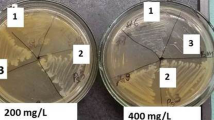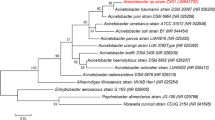Abstract
The usage of degrading bacterial strains has emerged as an innovative method to reduce pollution resulting from herbicide application. In 2022–2023, bacterial strains capable of degrading atrazine and metribuzin were isolated and identified from contaminated soils of six sugarcane farms in Khuzestan province, Iran. The study found 13 strains capable of growing in a specific culture medium (SSM) containing 10% atrazine, and 10 strains in a metribuzin-containing medium. Phenotypic tests, along with amplification of the 16S rRNA gene region, identified Stenotrophomonas sp, Brucella sp, Ensifer adhaerens, Pseudomonas aeruginosa, and Pseudomonas putida for atrazine, and Stenotrophomonas sp, Brucella sp, and E. adhaerens for metribuzin. Furthermore, the results indicated that E. adhaerens and Brucella sp. were able to grow on a combination of these two herbicides. Stenotrophomonas sp 22A displayed the lowest minimum inhibitory concentration (MIC) value (120 μL/mL) for atrazine, while Brucella sp 64A exhibited the highest MIC value at (230 μL/mL). Furthermore, the lowest MIC value for metribuzin was observed in Stenotrophomonas sp 63 M (180 μL/mL), in contrast to E. adhaerens 90 M which recorded the highest MIC value (230 μL/mL). The growth curve of bacterial absorbance rate (OD600) was measured using a microplate reader, and P. aeruginosa 15A and Stenotrophomonas sp 63 M had the highest degradation rate for atrazine and metribuzin, respectively. In conclusion, the use of degrading bacterial strains has notable potential as a method for reducing pollution resulting from herbicide use.





Similar content being viewed by others
References
Ahmad, S.A., K.N.E. Ku Ahamad, W.L. Wan Johari, M.I.E. Halmi, M.Y. Shukor, and M.T. Yusof. 2014. Kinetics of diesel degradation by an acrylamide-degrading bacterium. Rendiconti Lincei 25: 505–512. https://doi.org/10.1007/s12210-014-0344-7.
Ahmadi, A., Mirzaei najafgholi, H., Aeini, M., & Kakolvand, K. 2021. Isolation and identification of Othello, Atlantis, and Puma super herbicide-resistant bacteria isolated from the soil of wheat farms. Biological Journal of Microorganism 10(37): 67–77. https://doi.org/10.22108/bjm.2020.122745.1296
Awan, T.H., A. Ali, M. Tariq, A. Hussain, and U.F. Awan. 2019. Weed management strategies for sugarcane cultivation: A review. Sugar Tech 21 (1): 1–15. https://doi.org/10.1007/s12355-018-0658-6.
Babich, H., Stotzky, G., and Boethling, R. S. 2016. Bacterial degradation of herbicides. In Handbook of Environmental Chemistry pp. 1–54. Cham: Springer.
Bhalerao, T.S., P.R. Puranik, and D.N. Deobagkar. 2003. Biodegradation of the herbicide 2,4-dichlorophenoxyacetic acid by a strain of Bacillus niacini. Biotechnology Letters 25 (3): 239–243. https://doi.org/10.1023/A:1022563805730.
Bhatt, P., Patel, H., and Rawal, C. M. 2021. Isolation, characterization, and optimization of atrazine-degrading bacterial strain Pseudomonas sp. BP-5 from the agricultural soil of Gujarat, India. Environmental Science and Pollution Research 28(4): 4093–4102. https://doi.org/10.1007/s11356-020-11718-5
Budeguer, F., Enrique, R., Perera, M. F., Racedo, J., Castagnaro, A. P., Noguera, A. S., and Welin, B. 2021. Genetic transformation of sugarcane, current status and future prospects. Frontiers in Plant Science 12:768609. https://doi.org/10.3389/fpls.2021.768609
Das, S., and Singh, J. 2021. Bioremediation: A sustainable approach for environmental pollution management. Environmental Technology and Innovation 23:101634. https://doi.org/10.1016/j.eti.2020.101634
Firdous, S., S. Iqbal, S. Anwar, and H. Jabeen. 2018. Identification and analysis of 5-enolpyruvylshikimate-3-phosphate synthase gene from glyphosate-resistant Ochrobactrum intermedium Sq20. Pest Management Science 74 (11): 2516–2525. https://doi.org/10.1002/ps.4624.
Hernández, M., Villalobos, P., Morgante, V., González, M., Reiff, C., Moore, E., and Seeger, M. 2008. Isolation and characterization of a novel simazine-degrading bacterium from agricultural soil of central Chile, Pseudomonas sp. MHP41. FEMS Microbiology Letters 286(2):184–190. https://doi.org/10.1111/j.1574-6968.2008.01274.x
Kafilzadeh, F., and N. Farhadi. 2015. Molecular identification and resistance investigation of atrazine degrading bacteria in the sediments of Karun River, Ahvaz, Iran. Microbiology 84: 531–537. https://doi.org/10.1134/S0026261715040098.
Karamba, K.I., S.A. Ahmad, A. Zulkharnain, M.A. Syed, K.A. Khalil, N.A. Shamaan, F.A. Dahalan, and M.Y. Shukor. 2016. Optimisation of biodegradation conditions for cyanide removal by Serratia marcescens strain AQ07 using one-factor-at-a-time technique and response surface methodology. Rendiconti Lincei 27 (4): 665–678. https://doi.org/10.1007/s12210-016-0516-8.
Karpouzas, D.G., and B.K. Singh. 2019. Microbial degradation of organophosphorus xenobiotics: Metabolic pathways and molecular basis. Advances in Microbial Physiology 75: 1–47. https://doi.org/10.1016/bs.ampbs.2019.03.001.
Kumar, S., G. Stecher, M. Li, C. Knyaz, and K. Tamura. 2018. MEGA X: Molecular evolutionary genetics analysis across computing platforms. Molecular Biology and Evolution 35 (6): 1547.
Li, J., Zhang, Y., Wang, Y., Yang, Y., Chen, C., and Zhang, X. 2020. Herbicides in surface water and groundwater in China: Status, sources, and ecological risk. Journal of Hazardous Materials 383:121142. https://doi.org/10.1016/j.jhazmat.2019.121142
Li, J., Zhang, W., Lin, Z., Huang, Y., Bhatt, P., and Chen, S. 2021. Emerging strategies for the bioremediation of the phenylurea herbicide diuron. Frontiers in Microbiology 12:686509. https://doi.org/10.3389/fmicb.2021.686509
McAuliffe, K.S., L.E. Hallas, and C.F. Kulpa. 1990. Glyphosate degradation by Agrobacterium radiobacter isolated from activated sludge. Journal of Industrial Microbiology 6 (3): 175–179. https://doi.org/10.1007/BF01577700.
Mishra, S., and Jyothsna, M. 2018. Environmental impact of herbicides. In Herbicides, Theory and Applications,161–181. IntechOpen. https://doi.org/10.5772/intechopen.74347
Mojarad, M., Alamzad, A., Qureishi, G., and Javaheri, M. 2017. Evaluation of growth and decomposition potential of kerosene by several bacteria isolated from soil and water contaminated with petroleum compounds. Environment and Natural Resources Journal 70(1): 161–172. https://doi.org/10.32526/ennrj.16.017.
Mokrani, T., J.M. Pags, and M.P. Charnay. 2016. Biodegradation of the herbicide metribuzin by a new strain Ensifer adhaerens Zm6. Journal of Environmental Sciences 41: 43–50. https://doi.org/10.1016/j.jes.2015.05.024.
Naseri, H., Parashkoohi, M. G., Ranjbar, I., and Zamani, D. M. 2020. Sustainability of quantitative and qualitative indicators of sugarcane production under different tillage systems (case study: Khuzestan province of Iran). Environmental and Sustainability Indicators 8: 100046. https://doi.org/10.1016/j.indic.2020.100046.
Nyathi, P., Bezuidenhout, C. C., and Dubey, S. K. 2020. Biodegradation of atrazine and metribuzin: A review. Journal of Environmental Management 257: 109973. https://doi.org/10.1016/j.jenvman.2019.109973.
Rezaei, M., M. Shams-Bakhsh, and A. Alizadeh. 2012. Genetic diversity among Xanthomonas citri subsp. citri strains in Iran. Journal of Plant Protection Research 52: 1–9. https://doi.org/10.2478/v10045-012-0001-1.
Saha, S., S. Rana, and A.K. Gautam. 2017. Monitoring of pesticide residue in sugarcane juice and their potential health hazards in human population. Environmental Monitoring and Assessment 189 (1): 4. https://doi.org/10.1007/s10661-016-5734-9.
Sahoo, S.K., N. Sharma, K. Mandal, and R. Kumar. 2021. Dissipation kinetics of Metribuzin in sugarcane and soil under sub-tropical conditions of Punjab in India. Sugar Tech 23: 1359–1365. https://doi.org/10.1007/s12355-020-00937-5.
Schaad, N.W., J.B. Jones, and W. Chun. 2001. Laboratory Guide for Identification of Plant Pathogenic Bacteria, 3rd ed. St. Paul, MN: APS Press.
Seeger, M., M. Hernández, V. Méndez, B. Ponce, M. Córdova, and M. Gonzalez. 2010. Bacterial degradation and bioremediation of chlorinated herbicides and biphenyls. Journal of Soil Science and Plant Nutrition 10 (3): 320–332. https://doi.org/10.4067/S0718-95162010000100007.
Seiber, J.N., D.E. Glotfelty, A.D. Lucas, M.M. McChesney, J.C. Sagebiel, and T.A. Wehner. 1990. A multiresidue method by high performance liquid chromatography-based fractionation and gas chromatographic determination of trace levels of pesticides in air and water. Archives of Environmental Contamination and Toxicology 19 (2): 214–227. https://doi.org/10.1007/BF01059079.
Sekine, M., R. Hara, and C. Katsuyama. 2006. Isolation and characterization of atrazine-degrading bacteria from soil contaminated with pesticides. Journal of Bioscience and Bioengineering 102 (1): 26–31. https://doi.org/10.1263/jbb.102.26.
Sharafizadeh, P., and A. Nikpay. 2018. Assessment of degradation trend of three pre-emergence herbicides in sugarcane fields. The Scientific Promotional Journal of the Sugarcane Technology in Iran 43: 20–24.
Singh, B.K. 2019. The microbiome of soil and its ability to confer plant growth and health. Annual Review of Microbiology 73: 69–88. https://doi.org/10.1146/annurev-micro-090817-062343.
Singh, B.K., A. Walker, and J.A.W. Morgan. 2004. Biodegradation of chloro-s-triazine herbicides by Ensifer adhaerens strain S2 isolated from atrazine-treated soil. Applied and Environmental Microbiology 70 (4): 2304–2310. https://doi.org/10.1128/AEM.70.4.2304-2310.2004.
Souza, T.L., M.S. Da Silva, S.O. De Paula, and M.V. De Queiroz. 2019. Isolation and characterization of bacteria from soil contaminated with herbicides for potential use in bioremediation. Journal of Environmental Science and Health Part B 54 (7): 552–558. https://doi.org/10.1080/03601234.2019.1626761.
Taheri, Z., Ghasemian Rodsari, F., and Afshari, M. 2017. Isolation and identification of metribuzin herbicide-degrading bacteria from contaminated cultivated soils of Zanjan province. Agricultural Biotechnology 8(1): 11–18. https://doi.org/10.22084/ab.2017.2266
Teixeira, W., G., Dias, L. A. S., Fernandes, M.F., et al. 2019. Herbicides in sugarcane: A review of environmental impacts. Sugar Tech 21 (1): 16–29. https://doi.org/10.1007/s12355-018-0659-5.
Thompson, J.D., D.G. Higgins, and T.J. Gibson. 1994. CLUSTAL W: Improving the sensitivity of progressive multiple sequence alignment through sequence weighting, position-specific gap penalties and weight matrix choice. Nucleic Acids Research 22 (22): 4673–4680.
Vila, J., M. Tauler, and M. Grifoll. 2007. Biodegradation of the herbicide metribuzin by the ligninolytic fungus Pleurotus ostreatus. Journal of Agricultural and Food Chemistry 55 (20): 8184–8191. https://doi.org/10.1021/jf071769n.
Wang, G., J. Sun, S. Li, J. Zhang, J. Li, and B. Zhao. 2019. Isolation, identification and characterization of a novel Pseudomonas aeruginosa strain capable of degrading atrazine. Pesticide Biochemistry and Physiology 155: 36–42. https://doi.org/10.1016/j.pestbp.2019.02.002.
Wang, X. J., and Xie, Z. Y. 2012. Isolation and characterization of a novel Sphingomonas sp. strain capable of degrading polycyclic aromatic hydrocarbons and alkane hydrocarbons. Journal of Environmental Sciences 24(8): 1474–1482. https://doi.org/10.1016/S1001-0742(11)61085-0.
Weisburg, W.G., S.M. Barns, D.A. Pelletier, and D.J. Lane. 1991. 16S ribosomal DNA amplification for phylogenetic study. Journal of Bacteriology 173 (2): 697–703. https://doi.org/10.1128/JB.173.2.697-703.
Yen, P.Y., H.M. Chiang, and W.L. Chao. 1986. Bacterial degradation of the herbicide diuron. Applied and Environmental Microbiology 52 (1): 176–179. https://doi.org/10.1128/AEM.52.1.176-179.1986.
Zhang, J., Y. Wang, L. Wu, J. Wang, and B. Zhao. 2018. Atrazine degradation by a novel Pseudomonas sp. strain HB-6 isolated from contaminated soil. Journal of Environmental Management 224: 261–267. https://doi.org/10.1016/j.jenvman.2018.07.009.
Zhang, Y., Wang, Y., Wu, L., and Li, J. 2020. Herbicide contamination in agricultural soils in China: Status, sources, and potential risks. Environmental Pollution 265(Pt B): 114989. https://doi.org/10.1016/j.envpol.2020.114989.
Zhu, J., L. Fu, C. Jin, Z. Meng, and N. Yang. 2019. Study on the isolation of two atrazine-degrading bacteria and the development of a microbial agent. Microorganisms 7 (3): 80. https://doi.org/10.3390/microorganisms7030080.
Funding
The authors are grateful for research Grant from the Research Council of Shahid Chamran University of Ahvaz, with Grant Number SCU.AP1401.33951.
Author information
Authors and Affiliations
Contributions
MA conceived and designed the study. SM did the experiment with assistance of HMN and HMR. MA and SM interpreted the data. MA wrote the article while all authors revised the manuscript.
Corresponding author
Ethics declarations
Conflict of interest
The authors declare that they have no conflict of interest.
Additional information
Publisher's Note
Springer Nature remains neutral with regard to jurisdictional claims in published maps and institutional affiliations.
Supplementary Information
Below is the link to the electronic supplementary material.
Rights and permissions
Springer Nature or its licensor (e.g. a society or other partner) holds exclusive rights to this article under a publishing agreement with the author(s) or other rightsholder(s); author self-archiving of the accepted manuscript version of this article is solely governed by the terms of such publishing agreement and applicable law.
About this article
Cite this article
Mirzavand, S., Aeini, M., Najafgholi, H.M. et al. Identification and Characterization of Bacterial Strains Capable of Degrading Atrazine and Metribuzin Herbicides in Sugarcane Fields. Sugar Tech 26, 95–105 (2024). https://doi.org/10.1007/s12355-023-01323-7
Received:
Accepted:
Published:
Issue Date:
DOI: https://doi.org/10.1007/s12355-023-01323-7




